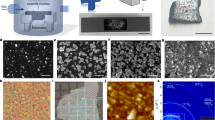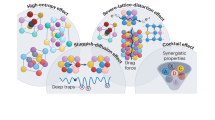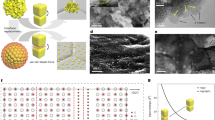Abstract
CURRENT theories of the cause of brittleness in ‘pure’ chromium ascribe the phenomenon to Cottrell locking1, invoking the Mott–Stroh2,3 theory of crack formation as the operative mechanism of brittle fracture, and nitrogen as the associated interstitial solute atom. There are several features of the tensile behaviour of annealed chromium (containing approximately 0.002 per cent nitrogen and 0.015 per cent oxygen), however, which this picture does not wholly explain, namely: (1) the very high temperature up to which embrittlement extends (about 350° C.) compared with other body-centred cubic metals of similar structure such as α-iron, molybdenum and tungsten; (2) the abrupt nature of the transition from a highly ductile condition to a completely brittle one, behaviour which again differs markedly from other body-centred cubic metals; (3) the fact that embrittlement occurs (at this nitrogen level) at the bottom of a trough in the maximum stress/temperature and yield stress/temperature curves just below 350° C.4, and not on the steeply rising part of the yield stress/temperature curve, which occurs only below 200° C., and which has been ascribed directly to Cottrell locking.
This is a preview of subscription content, access via your institution
Access options
Subscribe to this journal
Receive 51 print issues and online access
$199.00 per year
only $3.90 per issue
Buy this article
- Purchase on Springer Link
- Instant access to full article PDF
Prices may be subject to local taxes which are calculated during checkout
Similar content being viewed by others
References
Wain, H. L., Henderson, F., and Johnstone, S. T. M., J. Inst. Met., 83, 133 (1954).
Mott, N. F., J. Iron St. Inst., 183, 233 (1956).
Stroh, A. N., Phil. Mag., 46, 968 (1955).
Weaver, C. W. (unpublished work).
Hundy, B. B., Metallurgiea, 53, 203 (1956).
Caplan, D., Fraser, M. J., and Burr, A. A., “Solubility of Oxygen and Nitrogen in Solid Chromium”, a paper presented at the Conference on Ductile Chromium Metal and Its Alloys, National Metal Congress (Philadelphia, October, 1955).
Krupnik, N., and Ford, H., J. Inst. Met., 81, 601 (1953).
Kubaschewski, O., and Evans, E. L., “Metallurgical Thermochemistry”, 306 (Butterworth-Springer, London, 1951).
Thomas, W. R., and Leak, G. M., J. Iron St. Inst., 180, 155 (1955).
Author information
Authors and Affiliations
Rights and permissions
About this article
Cite this article
WEAVER, C. Strain–Age Hardening and Brittleness in Chromium. Nature 180, 806–808 (1957). https://doi.org/10.1038/180806b0
Issue Date:
DOI: https://doi.org/10.1038/180806b0
This article is cited by
-
Ductile-brittle transition of thoriated chromium
Metallurgical Transactions (1972)
-
Interaction of Spinel Crystals and Chromium Nitride in Chromium
Nature (1965)
-
‘Twinning’ and Fracture in Chromium
Nature (1962)
Comments
By submitting a comment you agree to abide by our Terms and Community Guidelines. If you find something abusive or that does not comply with our terms or guidelines please flag it as inappropriate.



